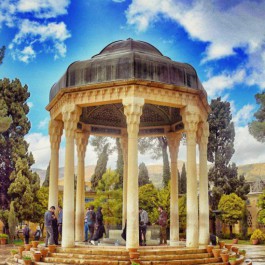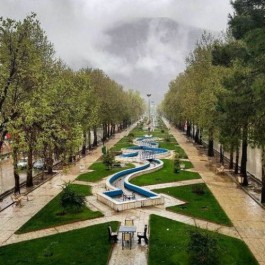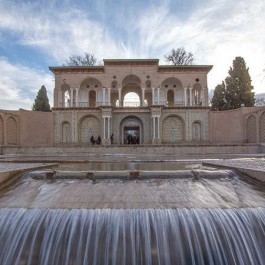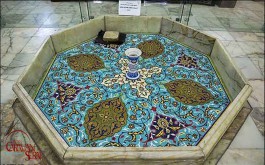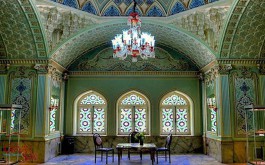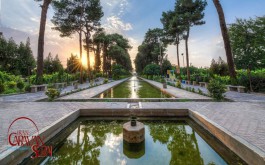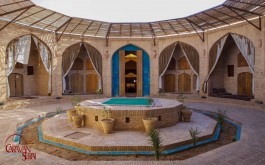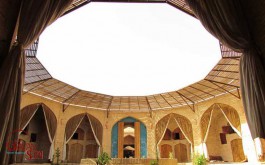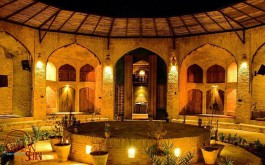Yazd is one of Iran's metropolises and also the capital of Yazd province that is located in the center of Iran. Yazd is one of Iran's tourist destinations and an appropriate city for arranging tours. Yazd is the first adobe city in the world, and following Venice in Italy, it is the second historic city throughout the globe.
Yazd County is located in a vast arid valley where is surrounded by Shirkuh and Kharanaq mountain ranges. Yazd city has also been known as "Dar-al-Ebadeh" (house of pray), "the city of wind catchers" (wind catcher is a traditional Iranian architectural element for creating natural ventilation in buildings) and "the city of bicycles". The famous slogan of the city is "the land of Qanat (Qanat is a gently sloping underground channel to transport water from an aquifer or water well to surface for irrigation and drinking), Qunut (Qunut is a supplication type of prayer made while standing in Islam), and Qanaat (contentment).
Yazd is among the driest cities in Iran that it was announced as the city with the lowest annual precipitation rate throughout the country, for several times.
Amir Chakhmaq
Amir Chakhmaq is a Complex consists of an urban open space, Tekyeh (a place where Shia Muslims gather to mourn Muharram), Bazaar, Ab anbar (a traditional water reservoir) and a spectacular mosque. The complex dates back to Timurid Empire in the 16th century AD. The complex was constructed by Jalal ed-Din Amir Chakhmaq Shami, who was the ruler of the city at that time. Amir Chakhmaq Tekyeh was registered as a national heritage in 1951. To visit the complex, you need to go to Imam Avenue, Amir Chakhmaq square.
Jameh Mosque
Jameh Mosque of Yazd is a unique building that was registered as a national heritage in 1934. This splendid building was constructed in the west side of Imam Khomeini Avenue, within an old neighborhood of Yazd. Jameh Mosque of Yazd includes a high Iwan (a rectangular hall or space, usually vaulted, walled on three sides, with one end entirely open), two Shebestans (an underground space that can be usually found in traditional architecture of mosques, houses, and schools in ancient Iran), two Garm Khanehs, Gonbad Khane, two Payabs (a part of building's structure for easy access to underground water), and a vast rectangular Sahn (a courtyard in Islamic architecture). Jameh Mosque of Yazd possesses 6 entries in different parts of the mosque.
Zein-o-din Caravansary
Zein-o-din Caravansary dates back to 400 years ago which was built by the command of King Abbas. The caravansary is a two-storey building in a 60 kilometers distance to Yazd- Kerman road that was built with clay bricks. UNESCO awarded the best renovated building association awards to Zein-o-din caravansary in 2006.
Maybod Ice House
Maybod Ice House Building (Maybod Adobe Yakhchal) is located in a 50 kilometers distance to the north of Yazd where was a building for producing ice. The ice house was composed of three main parts called "shading wall" (a wall creates shadow to cool water), a "pool for producing ice" and an "ice reservoir". Adobe and clay were the materials were used for building the ice house since they were the best insulation which prevented heat from entering and cool air from exhaustion. Maybod ice house dates back to the period prior to Qajar era (probably Safavid dynasty) that was considered as the largest ice house in its kind.
Lariha House
Lariha House in Yazd dates back to Qajar era. The house was constructed 150 years ago and Haj Muhammad Ibrahim Lari was its landlord. The mansion consists of six houses with the architecture of desert houses which were used as Nematollahi Khanqah (a place for spiritual retreat and character reformation). Lariha house was registered as a national heritage in February 1997. To access Lariha House, you can go to Imam Khomeini Avenue, Fahadan neighborhood. The mansion is located near the pavilion.
Dowlat Abad Garden
Dowlat Abad Garden is one of the most beautiful Iranian gardens that is situated in Shahid Rajaei Avenue, in the city center of Yazd. To enter the garden you need to pass a relatively large vestibule (also known as arctic entry which is an anteroom or small foyer leading into a larger space) where Yazd handicraft are sold. The building of Dowlat Abad Garden is a remnant from Afsharieh and Zandieh dynasties. Green space, fruit trees, beautiful flowers in the garden's yard, create a wonderful atmosphere. Dowlat Abad Garden consists of the portal mansion, vestibule building, wind catcher (Badgir), Behesht Aein mansion, Ayeneh hall, Tehrani mansion, Abanbar (a traditional reservoir of drinking water in ancient Iran), and Naser garden. The garden has also a high wind catcher which is considered as the highest wind catcher throughout the world.
Museum of mirrors
Museum of mirrors and lighting is the only museum specialized for light in the country. The museum was established in 1998 after renovating "Sarafzadeh House". Different types of lighting systems can be found in the museum such as: Pieh Sooz (lighting by ship's fat), Sham Sooz (lighting by candle), Naft Sooz (lighting by oil), and other electrical objects. The museum's objects are made by materials such as pottery, glass, brass, copper, and bronze. The building of the museum is a Kushk (a small garden pavilion open on some or all sides common in Iran) within the garden that was built during the first Pahlavi dynasty. The museum is located in Kashan street, in front of Haft-e Tir park, in Yazd.
Yazd Khan Bath was built by the command of Yazd ruler in 1797. The building was constructed in Qajar era which was known as Khan bath because most of its users were the city's authorities. In the past, apart from using the building as a local place for bath, it was a place for leisure, talking, resting and gathering. Currently, the building was renovated and converted to a restaurant and a traditional café which attract many tourists.
Tower of Silence (Borj-e Khamushan) is located in a 15 kilometers distance to the south east of Yazd city. The building was a Dakhma built by Zoroastrians for excarnation – that is, for dead bodies to be exposed to carrion birds, usually vultures. The remained bones of dead bodies were put into the empty space of Dakhma. The tower is situated on a high mountain in Safaeie region, Yazd.
Watermill was a structure for milling wheat and other grains that works by the speed and pressure of water. Ashkdez Watermill is among the largest mills in Iran which was built in Safavid dynasty and worked with the great power of Hemmat Abad Qanat's water.
